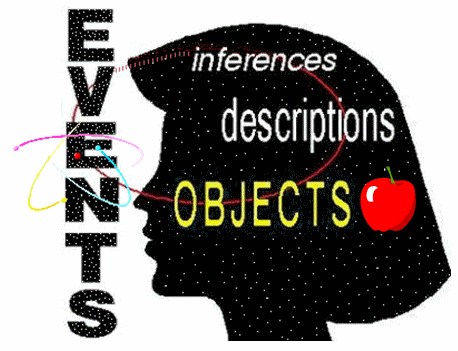
A General Semantics Perspective
on 'Critical Thinking'
Based on a talk delivered by Steven Lewis
at the MCC Faculty Convocation / October 1994.
The teaching of critical thinking skills -- or "proper evaluation" -- has become a popular topic within the academic community. The term "critical thinking" does not in itself convey specifically what it is that we are supposed to teach. Often what is taught as critical thinking in one course has little relationship to what is taught in a different one.
My purpose today is to present a simple, highly teachable principle that can be used to teach critical thinking in kindergarten through graduate school, in literature class or anatomy class. The generality of this principle and its easy verifiability make it a relatively non-controversial means of introducing critical thinking into your classes.
The principle of individuality was introduced by Alfred Korzybski in 1933 as the principle of non-identity. It means that no two situations or people or parts of situations or stages of processes are exactly the same. If we observe closely enough, we can always find differences. Many errors of evaluation are due to a disregard of this principle. These errors are promoted by the structure of our language, which often suggests similarities at the expense of differences.
For example, each of us has a name usually given to us at birth. We may have been labeled "Steven Lewis" or "Bill Clinton." Although the name allows us to differentiate one person from another, it does not call attention to the differences in an individual at different stages of life. We are not the same person today that we were when we were five years old. Not only do we change, but so does the environment in which we live. If we overvalue by the similarities evoked by a name, and undervalue by the actual differences, we might miss an opportunity to turn a once unpleasant relationship into a profitable one.

The deceased Supreme Court Justice Hugo Black is widely respected as a jurist whose decisions staunchly defended civil rights for minorities. Yet Black in his youth was a member of the Ku Klux Klan. His name was "Hugo Black" as a Klan member, and it was "Hugo Black" as a civil rights advocate. Clearly, the name is misleading. If we had over-evaluated by the name we would have missed the benefit of his growth as a person.
Most of us have had the experience of students who have returned to school and who have been among our best students. Yet they tell us that in high school, or on their initial attempt at college, they performed among the worst. Their names don't warn us to beware of the differences, and if we label them a failure because of their distant academic history, we may misvalue their potential to succeed in the present.
Our names also don't warn us about our different personalities in different contexts. The name "Steven Lewis" implies one person, and yet I am many people. We may be a different person with our mothers than with our supervisors than with our colleagues than with our students than with our lovers. We are different at a party than at a funeral, and we are different when exhausted than when we're rested. These differences are obscured by our labels.
Recall the story of the blind men and the elephant. Each man evaluated the elephant from a slightly different perspective, and so each had a quite different impression about the "real" nature of the elephant. Which blind man was right? They were each right from their limited perspective, and each was incomplete in their knowledge of the elephant. Our knowledge of most of the people who we encounter is necessarily going to be grossly incomplete, yet often we form generalizations on the basis of a couple of experiences and then refuse to modify those judgements even as conflicting data arrive. Once we label a person, the label often becomes a self-fulfilling prophesy.
 This tendency to overgeneralize affects students who do poorly on a test or in a class and then conclude that they are a failure or stupid. If a student does poorly on a test and generalizes that they are a failure, I remind them that actually they did poorly on the test, but there will be other tests and they may do much better on them. I also remind them that even if they do not do well at a particular endeavor -- maybe biology classes -- they are no doubt good in other things -- perhaps at art or working with people .... No one is good at all things ... Michael Jordan was not successful as a professional baseball player, but he was one of the most successful at basketball. That he failed to make the major leagues of baseball did not make him a "failure," it meant merely he failed to make it to the major leagues of baseball.
This tendency to overgeneralize affects students who do poorly on a test or in a class and then conclude that they are a failure or stupid. If a student does poorly on a test and generalizes that they are a failure, I remind them that actually they did poorly on the test, but there will be other tests and they may do much better on them. I also remind them that even if they do not do well at a particular endeavor -- maybe biology classes -- they are no doubt good in other things -- perhaps at art or working with people .... No one is good at all things ... Michael Jordan was not successful as a professional baseball player, but he was one of the most successful at basketball. That he failed to make the major leagues of baseball did not make him a "failure," it meant merely he failed to make it to the major leagues of baseball.
If we teach ourselves and our students the principle of individuality, we will be teaching them not to overgeneralize, to stay closer to the unique facts of a situation. Nutrition is an area where there is much confusion today that is in part the result of under-evaluating by individuality. Many people are afraid to eat certain foods, evaluating them as toxic. Some people eat lots of certain foods that they label health foods. Both types are over-evaluating by generality, under-evaluating by individuality.
 Let us use a banana as an example. Most people would say that bananas are good food. Eat a banana, it's good for you. Yet I know a person who followed that advice and nearly died as a result of it. He had to be rushed to the hospital in an ambulance and covered in ice to get his temperature down. He has an unusual response to bananas, and must be careful not to eat any foods that have bananas in them.
Let us use a banana as an example. Most people would say that bananas are good food. Eat a banana, it's good for you. Yet I know a person who followed that advice and nearly died as a result of it. He had to be rushed to the hospital in an ambulance and covered in ice to get his temperature down. He has an unusual response to bananas, and must be careful not to eat any foods that have bananas in them.
Most of us respond peculiarly and detrimentally to some foods. These foods may be perfectly fine in moderate amounts for most people, but for some they are a problem.
Many folks cannot drink milk. Milk allergies and intolerances are really quite common, yet there are a lot of nutrients in generous quantities in milk. So the nutrition authorities recommend several servings of dairy products each day for adults. You may like milk and tolerate milk well, but if you take the recommendations too literally you could harm someone by telling them, "Drink your milk ... it is good for you!" For them, in fact, it may be quite harmful!
I tell my students that the committees that put together food consumption recommendations did not study them personally, so their recommendations may not apply to them. If they cannot tolerate a food, don't eat it because some committee in a far away place advises it! Here we are teaching students to evaluate by the principle of individuality, to evaluate by their own uniqueness.
On the other hand, someone may have a glass of milk and have a terrible experience. Instead of properly evaluating the situation and saying merely, "I should not drink milk," they instead say "Milk is bad ... no one should drink milk." They overgeneralize from personal preferences. Teaching the principle of individuality will counteract this tendency to evaluate a person, or group of persons or a food as being all bad or all good and then projecting our evaluations onto future encounters with this person or food.
Take, for example, Vitamin A. We call it a "vitamin" so it must be good for us! A lot of people think a substance like "Vitamin A" must be absolutely good and, of course, you can't get enough of a good thing! As it turns out Vitamin A can kill if we don't get enough or if we get too much. The National Academy of Sciences recommends around 1,000 Retinol Equivalents of Vitamin A each day. If we consumed only 5 REs a day we would eventually get sick and die from too little Vitamin A. If we consumed 100,000 REs a day we would eventually get sick and die from too much.
Many people have become sick or died by disregarding the individuality of dose. A little may be good for you, but a lot may kill you. Even plain water can kill you if you drink too much. And if you fall in the lake and can't swim it can kill you even faster.
A similar evaluation can be applied to the botulism toxin. Here is a substance with toxin in its name, so we are forewarned to avoid it like the plague. An invisible and tasteless dose of the botulism toxin in our food can kill a human. Yet this "toxin" (Botox) is now injected routinely into the body to treat muscle spasms and migraine headaches and cosmetically to lessen the appearance of facial wrinkles. So is the botulism toxin good or bad for you? If we apply the principle of individuality we must say, "It depends on the context, including the dose." The botulism toxin is just another example of how labeling can become a self-fulfilling prophesy if we are not conscious of the uniqueness of each situation.
There are many Americans who are needlessly fearful about their food supply because they don't understand the principle of individuality. Take, for example, the issue of carcinogens in our food. The word "carcinogen" as used in our culture obscures so many important facts that it makes sane discussion of food safety risks pretty much impossible.
Let's look at the saccharin scare of the late 1970s. Saccharin was a non-calorie sweetener used in foods in the United States since World War I. A review of its safety led scientists to recommend in 1958 that saccharin be placed on the Generally Recognized as Safe list, the so-called GRAS list. Many diabetics and weight watchers used saccharin as a substitute for sugar. Then, in 1977, a Canadian study of rats found that saccharin could cause cancer. There was quite an uproar in America, and the Food and Drug Administration announced saccharin would be banned from the food supply. This ban was later rescinded by an act of Congress, but many people still fear saccharin and avoid it at all costs.
The application of the principle of individuality would alleviate many of these fears. First, saccharin has been found to cause cancer only in one species -- rats. Several other species have tested negative, including monkeys, mice and guinea pigs. Even among rats, saccharin caused an increased incidence of bladder cancer in male rats in the Canadian study, but not in female rats. Yet the media at the time focused on labeling saccharin a "carcinogen" without reference to species, as if a carcinogen in rats will automatically be a carcinogen in humans. On the contrary, the Canadian study showed that you couldn't even generalize from a male rat to a female rat when predicting saccharin's cancer causing abilities.
As of 1990, 392 chemicals had been tested for carcinogenicity in both mice and rats. Of these, 226 were found to cause cancer in at least one species; however 42% of these carcinogens caused cancer in ONLY one of these species! Just as there is a lot of variability within members of a species (many smokers get lung cancer, but most don't), there is clearly significant variability between species in cancer risks. If nearly half the known rodent carcinogens can't be generalized from one rodent species to another, how can we confidently generalize from male rats to humans?
The Canadian rat study also revealed another over-generalization in media reporting of "carcinogens" and in the way we test chemicals for carcinogenicity. The amount of saccharin fed to these rats was the equivalent to a human intake of 800 cans of diet pop a day! This was the maximally tolerated dose of saccharin for the rats in the study. This high dose was used so that relatively few animals could be used. The problem, of course, is that a substance may have different effects at different doses. No human would likely consume anywhere near that amount of saccharin in one day, let alone each day for their entire life! Nevertheless, the media generalized from these high doses to human doses and reported the study as if the dose were irrelevant. In fact, several essential nutrients in humans, including selenium and retinol (a form of Vitamin A), have been found to cause cancer when fed in high doses to some animal species. If we applied saccharin standards to these essential nutrients they would have to be banned from the human food supply. Yet many humans buy supplements of these nutrients from "health food stores" and swallow them gleefully!
We could train the public and the media in the details of toxicology to alleviate their exaggerated fears, but a more reasonable approach would be to train the public in the principle of individuality ... in this context meaning the individuality of species and of dose.
A decade after the saccharin scare came another food scare involving dioxin. Dioxin is a by-product of several manufacturing processes that involve chlorine. In 1989 a national stir followed the announcement that dioxin had been found in milk served from paper cartons. The dioxin had leached from the paper cartons into the milk, and several "consumer protection" groups and the media pointed out that school children are served milk from paper cartons. Newspaper stories of the dioxin-tainted milk invariably referred to dioxin as a carcinogen and led the reader to conclude that increased incidence of cancer would await the children exposed to the tainted milk.
Again, what was missing from these reports was the application of the principle of individuality. Dioxin was usually labeled simply a "carcinogen," without reference to the fact that it had been found to be a carcinogen in some animal species, but not in others. What was not reported in the media was that dioxin had been found to decrease the risk of some types of cancers in some species. Dioxin, in other words, could just as truthfully be labeled an anticarcinogen.
A second media over-generalization involved the amount of dioxin in milk. Most milk samples tested revealed no detectable dioxin, but the highest amount of dioxin in a tainted sample was measured at 0.07 parts per trillion. Most readers of newspapers would not have the slightest idea what these numbers mean, but 0.07 ppt is equal to 70 nanograms of dioxin in 1000 quarts of milk. In other words, if you took all the dioxin out of 1000 quarts of the most heavily contaminated sample of milk and placed it on the tip of your finger, you would not be able to see it with the unaided eye!
Failure to differentiate among individuals, among species, among doses is at the root of many of our food fears in our culture. We can counteract these tendencies to overgeneralize by teaching the principle of individuality in all our classes.
On the contrary, today many classes promote over-evaluation by generality, underevaluation by individuality. Examine a typical introductory anatomy text and you will find page after page of generalizations about the human body, but little warning that these generalizations do not exist outside of the textbook.
 For example, introductory texts in anatomy teach that the palmaris longus is a muscle in the forearm that flexes the wrist. There is no mention that many people do not have this muscle, or have attachment sites for the muscle quite different from what is reported in the book. In one study of 1600 upper extremities, the palmaris longus muscle was entirely absent 13 percent of the time.
For example, introductory texts in anatomy teach that the palmaris longus is a muscle in the forearm that flexes the wrist. There is no mention that many people do not have this muscle, or have attachment sites for the muscle quite different from what is reported in the book. In one study of 1600 upper extremities, the palmaris longus muscle was entirely absent 13 percent of the time.

The brachial biceps is the large muscle that flexes the elbow. The name "biceps" means two origins or heads. Yet one study of 150 extremities found that the biceps brachii had at least 3 origins in 5 percent of limbs. One limb had 5 origins. Should we call this muscle the pentaceps brachii?
These quite common "variations" found in the world outside the textbooks help account for why a Nolan Ryan could throw a baseball more than 95 miles an hour past the age of 40, while most pitchers can only dream of throwing such a fastball in their prime.
We need generalizations to speed up the processes of learning and communication, but a blatant disregard for the principle of individuality in a class can give the student a misleading sense of reality and doom them to needless fears and other assorted misevaluations.
Go to General Semantics Home Page ||| Go to Steven Lewis Home Page